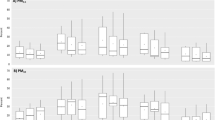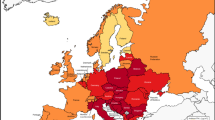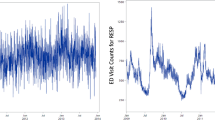Abstract
Multi-city population-based epidemiological studies of short-term fine particulate matter (PM2.5) exposures and mortality have observed heterogeneity in risk estimates between cities. Factors affecting exposures, such as pollutant infiltration, which are not captured by central-site monitoring data, can differ between communities potentially explaining some of this heterogeneity. This analysis evaluates exposure factors as potential determinants of the heterogeneity in 312 core-based statistical areas (CBSA)-specific associations between PM2.5 and mortality using inverse variance weighted linear regression. Exposure factor variables were created based on data on housing characteristics, commuting patterns, heating fuel usage, and climatic factors from national surveys. When survey data were not available, air conditioning (AC) prevalence was predicted utilizing machine learning techniques. Across all CBSAs, there was a 0.95% (Interquartile range (IQR) of 2.25) increase in non-accidental mortality per 10 µg/m3 increase in PM2.5 and significant heterogeneity between CBSAs. CBSAs with larger homes, more heating degree days, a higher percentage of home heating with oil had significantly (p < 0.05) higher health effect estimates, while cities with more gas heating had significantly lower health effect estimates. While univariate models did not explain much of heterogeneity in health effect estimates (R2 < 1%), multivariate models began to explain some of the observed heterogeneity (R2 = 13%).
This is a preview of subscription content, access via your institution
Access options
Subscribe to this journal
Receive 6 print issues and online access
$259.00 per year
only $43.17 per issue
Buy this article
- Purchase on Springer Link
- Instant access to full article PDF
Prices may be subject to local taxes which are calculated during checkout



Similar content being viewed by others
References
Dominici F, Peng RD, Bell ML, Pham L, McDermott A, Zeger SL, et al. Fine particulate air pollution and hospital admission for cardiovascular and respiratory diseases. JAMA . 2006;295:1127–34.
Franklin M, Zeka A, Schwartz J. Association between PM2.5 and all-cause and specific-cause mortality in 27 US communities. J Expo Sci Environ Epidemiol. 2007;17:279–87.
Baxter L, Franklin M, Özkaynak H, Schultz B, Neas L. The use of improved exposure factors in the interpretation of fine particulate matter epidemiological results. Air Qual Atmos Health. 2013;6:195–204.
Franklin M, Koutrakis P, Schwartz J. The role of particle composition and the association between PM2.5 and mortality. Epidemiology . 2008;19:680–9.
Bell ML, Ebisu K. Environmental inequality in exposures to airborne particulate matter components in the United States. Environ Health Perspect. 2012;120:1699–704.
Zeger SL, Thomas D, Dominici F, Samet JM, Schwartz J, Dockery D, et al. Exposure measurement error in time-series studies of air pollution: concepts and consequences. Environ Health Perspect. 2000;108:419–26.
Goldman GT, Mulholland JA, Russell AG, Gass K, Strickland MJ, Tolbert PE. Characterization of ambient air pollution measurement error in a time-series health study using a geostatistical simulation approach. Atmos Environ. 2012;57:101–8.
Chen C, Zhao B, Weschler CJ. Indoor exposure to “outdoor PM10”: assessing its influence on the relationship between PM10 and short-term mortality in U.S. cities. Epidemiology. 2012;23:870–8.
Zhou B, Zhao B, Guo X, Chen R, Kan H. Investigating the geographical heterogeneity in PM10-mortality associations in the China air pollution and health effects study (CAPES): a potential role of indoor exposure to PM10 of outdoor origin. Atmos Environ. 2013;75:271–23.
Bell ML, Dominici F. Effect modification by community characteristics on the short-term effects of ozone exposure and mortality in 98 US communities. Am J Epidemiol. 2008;167:986–97.
Hodas N, Lunden MM, Meng QY, Baxter LK, Özkaynak H, Burke J, et al. Heterogeneity in the fraction of ambient PM2.5 found indoors contributes exposure error and may contribute to spatial and temporal differences in reported PM2.5 health effect estimates. J Expo Sci Environ Epidemiol. 2012;22:448–54.
Janssen NAH, Schwartz J, Zanobetti A, Suh HH. Air conditioning and source specific particles as modifiers of the effect of PM10 on hospital admissions for heart and lung disease. Environ Health Perspect. 2002;110:43–9.
Medina-Ramon M, Zanobetti A, Schwartz J. The effect of ozone and pm10 on hospital admissions for pneumonia and chronic obstructive pulmonary disease: a national multicity study. Am J Epidemiol. 2006;163:579–88.
Allen R, Larson T, Sheppard L, Wallace L, Liu LJS. Use of real-time light scattering data to estimate the contribution of infiltrated and indoor-generated particles to indoor air. Environ Sci Tech. 2003;37:3484–92.
Chan WR, Nazaroff WW, Price PN, Sohn MD, Gadgil AJ. Analyzing a database of residential air leakage in the United States. Atmos Environ. 2005;39:3444–55.
Koenig JQ, Mar TF, Allen RW, Jansen K, Lumley T, Sullivan JH, et al. Pulmonary effects of indoor- and outdoor-generated particles in children with asthma. Environ Health Perspect. 2005;113:499–503.
Pandian MD, Ott WR, Behar JV. Residential air exchange rates for use in indoor air and exposure modeling studies. J Exp Anal Environ Epidemiol. 1993;3:407–16.
Bell ML, Ebisu K, Peng RD, Dominici F. Adverse health effects of particulate air pollution: modification by air conditioning. Epidemiology. 2009;20:682–6.
Johnson T, Long T. Determining the frequency of open windows in residences: a pilot study in Durham, North Carolina during varying temperature conditions. J Exp Anal Environ Epidemiol. 2005;15:329–49.
Ito K, Xue N, Thurston G. Spatial variation of PM2.5 chemical species and source-apportioned mass concentrations in New York City. Atmos Environ. 2004;38:5269–82.
Ito K, Mathes R, Ross Z, Nádas A, Thurston G, Matte T. Fine particulate matter constituents associated with cardiovascular hospitalizations and mortality in New York city. Environ Health Perspect. 2011;119:467–73.
Bell ML, Ebisu K, Peng RD, Samet JM, Dominici F. Hospital admissions and chemical composition of fine particle air pollution. Am J Respir Crit Care Med. 2009;179:1115–20.
Weichenthal S, Van Ryswyk K, Kulka R, Sun L, Wallace L, Joseph L. In-vehicle exposures to particulate air pollution in canadian metropolitan areas: the urban transportation exposure study. Environ Sci & Technol. 2014;29:597–605.
Liu X, Frey HC. Modeling of in-vehicle human exposure to ambient fine particulate matter. Atmos Environ. 2011;45:4745–52.
White House Office of management and budget. Revised delineations of metropolitan statistical areas, micropolitan statistical areas, and combined statistical areas, and guidance on uses of the delineations of these areas. 2013.
NCDC. National oceanic and atmospheric association, National climatic data center accessed January 2006 [Available from: http://www.ncdc.noaa.gov/oa/ncdc.html.
United States environmental protection agency. United States environmental protection agency, air quality system data mart accessed october 2012-august 2013 [Available from: http://www.epa.gov/ttn/airs/aqsdatamart.
Sarnat SE, Klein M, Sarnat JA, Flanders WD, Waller LA, Mulholland JA. An examination of exposure measurement error from air pollutant spatial variability in time-series studies. J Expo Sci Environ Epidemiol. 2010;20:135–46.
Baxter LK, Crooks JL, Sacks JD. Influence of exposure differences on city-to-city heterogeneity in PM2.5-mortality associations in US cities. Environ Health. 2017;16:1–8.
United States Census Bureau. United States Census Bureau, American FactFinder 2005 [Available from: http://factfinder.census.gov/faces/nav/jsf/pages/programs.xhtml?program=acs.
American housing survey (2011) U.S. census bureau. American housing survey for the United States. Washington, DC; 2009.
Baxter LK, Sacks JD. Clustering cities with similar fine particulate matter exposure characteristics based on residential infiltration and in-vehicle commuting factors. Sci Total Environ. 2014;470–471:631–8.
Prachi P, Povinelli RJ, Merrill SJ, Bozdag S, Sem DS. Novel uses of in vitro data to develop quantitative biological activity relationship models for in vivo carcinogenicity prediction. Mol Inform. 2015;34:236–45.
Zhang Y, Dong Z, Phillips P, Wang S, Ji G, Yang J, et al. Detection of subjects and brain regions related to Alzheimer’s disease using 3D MRI scans based on eigenbrain and machine learning. Frontiers in computational neuroscience. 2015;9.
Paixão P, Gouveia LF, Morais JAG. Prediction of the in vitro intrinsic clearance determined in suspensions of human hepatocytes by using artificial neural networks. Eur J Pharm Sci. 2010;39:310–21.
Baxter LK, Clougherty JE, Laden F, Levy JI. Predictors of concentrations of nitrogen dioxide, fine particulate matter, and particle constituents inside of lower socioeconomic status urban homes. J Expo Sci Environ Epidemiol. 2007;17:433–44.
Breen MS, Breen M, Williams RW, Schultz BD. Predicting residential air exchange rates from questionnaire and meterology: model evaluation in central North Carolina. Environ Sci Technol. 2010;44:9349–56.
Baxter LK, Stallings C, Smith L, Burke J. Probabilistic estimation of residential air exchange rates for population-based human exposure modeling. J Expo Sci Environ Epidemiol. 2017;27:227–34.
Breen MS, Schultz BD, Sohn MD, Long T, Langstaff J, Williams R, et al. A review of air exchange rate models for air pollution exposure assessments. J Expo Sci Environ Epidemiol. 2014;24:555–63.
Persily A, Musser A, Emmerich SJ. Modeled infiltration rate distributions for U.S. housing. Indoor Air. 2010;20:473–85.
Acknowledgements
The authors would like thank Ana Rappold of the U.S. EPA’s National Health and Environmental Effects Research Laboratory. The authors would like to thank Breanna Allman of the U.S. EPA’s Office on Air Quality Planning and Standards and Tom Long of the U.S. EPA’s National Center for Environmental Assessment for their review of this paper.
Author information
Authors and Affiliations
Corresponding author
Ethics declarations
Conflict of interest
The authors declare there are no competing interests.
Electronic supplementary material
Rights and permissions
About this article
Cite this article
Baxter, L.K., Dionisio, K., Pradeep, P. et al. Human exposure factors as potential determinants of the heterogeneity in city-specific associations between PM2.5 and mortality. J Expo Sci Environ Epidemiol 29, 557–567 (2019). https://doi.org/10.1038/s41370-018-0080-7
Received:
Revised:
Accepted:
Published:
Issue Date:
DOI: https://doi.org/10.1038/s41370-018-0080-7



